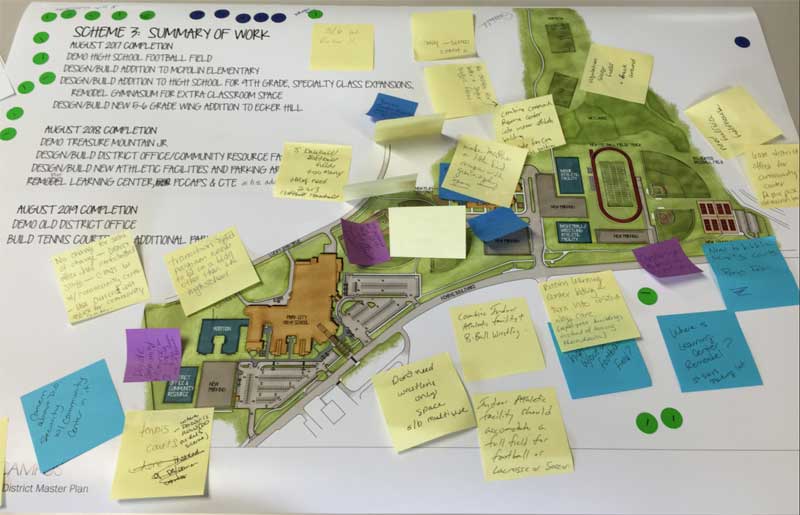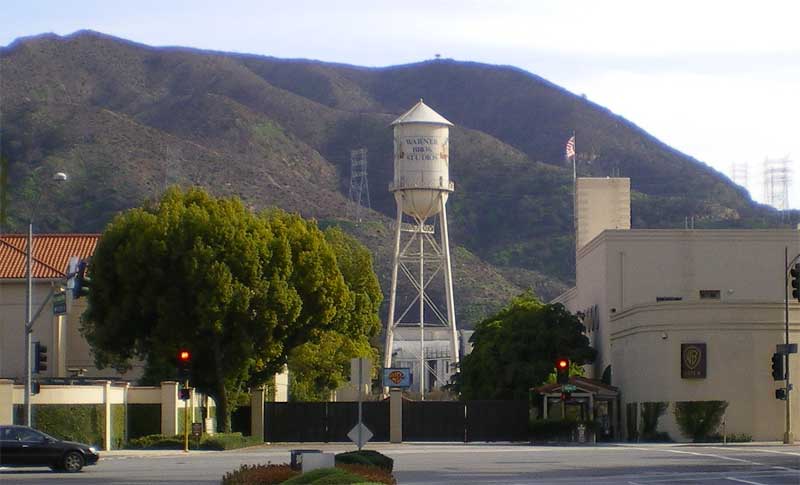Pinebrook Bear Has Been Captured
According to local reports, the Division of Wildlife Resources (DWR) have tranquilized one of the bears that was spotted around town. A black bear, approximately 6 feet tall and 250-300 pounds was spotted in a Pinebrook backyard. Summit County Animal Control was called and DWR officers were able to tranquillize the bear at about 9AM. It appears the plans are to relocate the bear to a safer location.
Below is a picture a citizen provided to us. The citizen reported that it was taken by Pinebrook resident Michael Knight.
School District Plan for Kearns
If you’ve been listening to KPCW, you’ll know that the School District is moving toward a preferred redesign of the Kearns campus and building a new 5/6 grade at the Ecker Hill site.
This includes
- New football field
- New baseball/softball fields
- New basketball/wrestling facility
- New tennis courts
- New indoor athletic facility
- New soccer field
- Addition to high school for 9th graders
- A new School District Office that incorporates a community center
- Tons of additional parking
- New 5th/6th school at Ecker Hill
Here is the “scheme” presented at the last community master planning meeting. It also has people comments on it, which reflects ideas and concerns by attendees. Click the image for a bigger version to see what is included and where it is:
Movie Studio Looks Just Like Another Office Building
I was driving by the Park City Film Studio this weekend and something struck me — the movie studio looks just like any other office building. I guess I had this mental image of people visiting town, driving in on 248, looking left, and being amazed by this movie studio. Now when I look at it all I can think of is a larger version of the Weller Recreation building that you see when you drive into Kamas.
I don’t know what I was expecting? Perhaps a water tower? I know it’s not needed but it’s so iconic. I guess decisions were made with function over form in mind. Will it really matter to someone who is deciding on whether they want to use the studio for a production? Not at all. Will it matter to the 2 million visitors driving past it over the next few years? Nah. They’ll just probably see a big office next to a hotel (the one that is also approved). Maybe that’s not optimal for Park City’s brand, since its one of two entry corridors to the city… but I guess the show must go on.
Or Perhaps the studio will opt for the biggest, most-neon movie studio sign you’ve ever seen. That’d be nice too. All we can do is wait and see.
Here’s what I think of when I think studio:
Kimball Arts Center Moving to Bonanza Park in September
The Kimball Arts Center announced today that it has found a new temporary home. In September it will be moving to 1401 Kearns Boulevard .
Robin Marrouche, Executive Director of the Kimball Art Center said, “The opportunity to build an entirely new facility that is truly customized to best fit the needs of our patrons is hands down the best way for us to continue to cultivate an arts culture here in Park City and beyond – and this temporary home is the first step toward realizing that exciting goal.”
Here is the press release:
KIMBALL ART CENTER SECURES NEW TEMPORARY HOME IN PARK CITY
The Kimball will move to 1401 Kearns Boulevard in September 2015
PARK CITY, Utah (May 18, 2015) – Today, the Kimball Art Center announced that it has signed a lease for a temporary location in Park City as part of a planned expansion project designed to increase access to the non-profit’s diverse and inspiring art education, exhibitions and events.
The Kimball Art Center’s new location will be located just a mile from Main Street in the Bonanza Park area at 1401 Kearns Boulevard. The organization plans on residing there for approximately three years while a new permanent art center is designed and built.
This transition to the new facility will take place in September 2015, and there will be no interruption in classes during this shift. Events such as the 46th Annual Park City Kimball Arts Festival will also continue as planned, kicking off on July 31st, 2015. While in the temporary space, the Kimball Art Center plans on exploring new educational offerings and experimenting with new programming for the future permanent home that fosters even greater appreciation and understanding of the arts among patrons.
“This is a really transformational time for the Kimball Art Center, as we will been looking for ways to grow and evolve to better serve the community we love so much,” said Robin Marrouche, Executive Director of the Kimball Art Center. “The opportunity to build an entirely new facility that is truly customized to best fit the needs of our patrons is hands down the best way for us to continue to cultivate an arts culture here in Park City and beyond – and this temporary home is the first step toward realizing that exciting goal.”
To better serve a continuously increasing demand from the community for the Kimball Art Center’s extensive art programs and offerings, the center’s Board of Directors made the decision to sell the current facility on Park City’s Historic Main Street. The sale of the current building, which closed earlier this month, will allow the Kimball Art Center to transition into its new space with increased square footage and improved parking and accessibility.
About the Kimball Art Center
Since 1976, the Kimball Art Center (KAC) has been the heart of Park City’s historic and vibrant arts community. The non-profit center for the arts is committed to engaging individuals of all ages in diverse and inspiring experiences through education, exhibitions and events – including the annual Park City Kimball Arts Festival, Utah’s original and longest-running visual arts festival, now in its 46th year. As the KAC’s biggest fundraiser, proceeds from the festival allow the center to provide free, year-round art exhibitions, gallery tours, monthly “Art Talks” as well as art education outreach to teachers, students and the community.
For more information on the KAC and its numerous community offerings and programs, please visit www.kimballartcenter.org.
Perhaps I Was Too Excited About The Mountain Accord Tunnel Being Scrapped
Yesterday I wrote that a Mountain Accord meeting on Monday indicated that the tunnel between Brighton and PCMR was dead. Let’s just say that I may have been wrong … or perhaps more precisely that the nails aren’t quite in the coffin yet.
I have received feedback from the community indicating where the potential for the tunnel, to come back to life, exists. Let’s look at some of those:
- A meeting of many of the parties associated with the Accord on Monday agreed to remove the tunnel from the “proposed actions” for the environmental phase (NEPA) of the Mountain Accord. Yet, this removal still needs to be voted on. Between now and that point lies a Mountain Accord retreat which could alter perspectives, and votes, of Accord members. So, removing the tunnel may not become reality… or more likely language will be constructed to make it appear that the tunnel is dead … but in reality it will be like one of those zombie movies where it will show its ugly head once again.
- Imminent domain could still put the tunnel in play. Imminent domain is the right of the state or federal government to do what they want for the “general good.” The Utah Department of Transportation (UDOT) could still decide they want a tunnel and theoretically nothing could stop it.
- If you look at the proposed language that is said to be added to the Mountain Accord Blueprint, it basically says “nothing can be done to someone” and that supposedly protects us from the Mountain Accord building a tunnel if we don’t want it. Yet, you have to ask who is “we”. Not to get all Monica Lewinsky and Bill Clinton on you, but the definition of “we” is important. In this case the “we” is the Park City City Council. The Park City Council actually represents a small portion of people in the area, compared to Summit County whose Summit County Council encompasses all the Snyderville Basin residents. Because of this, you have to account for the fact that Park City council people could be coopted into supporting a tunnel and there is nothing that most of us could do about it.
- Throughout the process, there have been allegations of conflicts of interest with regard to members of the Mountain Accord Executive Committee. Some of these alleged conflicts are with people at the highest levels of government. Since there has formally been nothing agreed upon, Mountain Accord representatives would tell you that there are no conflicts. That may be true and you should believe what you want, but what you should be concerned with is the process that this whole proposal will follow. If I’ve learned anything from following local government, is that there is usually an agenda. If there wasn’t, most actions wouldn’t be started. And the motto, “if at first you don’t succeed, try try again” is at the fore-front of my mind. The people running Mountain Accord are at least 3 steps ahead of the rest of us. If somone who is really important demands a tunnel to Park City, this minor setback won’t stop them. And in a process as complicated as this, there are plenty of places to re-insert that little hole through the mountain.
If you speak with those people in the know about the death of the tunnel, you’d likely describe them as cautiously optimistic. That said, I’m sure each of them would also advise constant vigilance.
Given quite a few discussions over the last 24 hours, I’d recommend that too.
My How Park City has Changed
An anonymous person sent a link to one of the greatest visualizations of Park City growth since 1984. This is one of those must sees.
Watch below or click here for a bigger view.
h/t to the person who sent this
Live Blogging the School Board Master Planning Meeting
The Park City School Board Master Planning Committee is meeting tonight. This is the final, of 3 meeting regarding building needs in the district. I am live blogging the meeting.
Park City Citizens Have Made a Difference With Regard to Mountain Accord
Park City and Snyderville Basin residents… We salute you.
On Monday, the Mountain Accord Executive Committee met to discuss comments they have received over the last few months. One of the outcomes of the meeting, according to local leader and activist Rich Wyman, who attended the session, is that the tunnel between Brighton and Park City has been scrapped from the proposed actions for the NEPA process. According to Mr. Wyman, Park City City Council member Andy Beerman and Summit County Council Member Chris Robinson told the Mountain Accord Executive Committee that their constituents were not in support of a tunnel connection to Park City. The Executive Committee evidently listened to our representatives and will likely remove the tunnel option from the Mountain Accord proposed actions.
In addition, it was stated that the following language would be added to the Mountain Accord Blueprint:
“Mountain Accord decisions are consensus based and do not supersede federal, state, and local jurisdictions’ authority. Local jurisdictions that have consented in the consensus based process shall seek to implement agreed-up scenarios or actions within their jurisdiction through zoning, general plan, and other tools available. Local jurisdictions are not obligated to implement actions with which they are not in agreement.”
This language was likely added because of Roger Armstrong, and other Summit County Council members, who demanded that the citizens of Summit County would not be forced, against our will, into allowing actions decided on by the Mountain Accord representatives.
While we still need to wait for the final language to be added to the next iteration of the Mountain Accord Blueprint, this appears to be a victory for the people of Park City and the Snyderville Basin. It proves that by getting involved, showing up at public meetings (like the Mountain Accord Meeting at the high school), and writing emails, that we can all make a difference. Without the people voicing their concerns, activists like Mr. Wyman raising awareness, and certain elected representatives willing to take a stand, the outcome likely would have been different. The Mountain Accord would probably have submitted a proposal to the government that included a tunnel to Park City and that tunnel probably would have turned into reality.
For at least now, that concern seems to be abated. In the future we may need to fight again to prevent a tunnel to Park City but today we can now concentrate on the good parts of the Mountain Accord — the environmental aspects.
It’s a good day to be part of a democratic republic. It’s a good day to know that your opinion actually counts and makes a difference.
Park City and Basin residents, if I could throw you a party I would.
You done good.
Update: I heard from Rich Wyman with regard to this article. He thought it was important to point out that the train was likely being scrapped from the proposed actions for the NEPA process. While he is optimistic that this is a great step towards ensuring that the train isn’t part of The mountain accord, nothing is definite yet. He said that additional conversations and votes had to happen to make this become a reality. Therefore, I have updated the story to reflect that as best as possible. Thanks to Rich for pointing this out.
Students are Learning That They Need Constant Vigilance Too
In some twist of irony it’s a little amusing that students are upset over the high school’s media center being repurposed as a location for PC CAPS. The purpose of PC CAPS is to give students real world experience. Yet, these students who are complaining about the school board making a decision look like they need to understand how the real world works. As one student put it, “They didn’t ask us. They should have, because we are the people who are going to be negatively impacted by this out-of-the-blue decision.”
I know I sound a bit condescending, and when I was in high school I would have been complaining too, just like these students. I probably wouldn’t have even been as good as these kids … I wouldn’t have even considered writing a letter to the paper. Yet that doesn’t change the fact that the school board did tell students, parents, and the community that they were considering making this change. It was announced on a School Board Meeting agenda. It was discussed on the radio. It was all available online. I believe there is even a student council representative “on” the School Board.
What these students are learning is the same thing I’ve been learning since I started Park Rag. Civic involvement isn’t a part time job. You have to be constantly aware of what is happening with local government. You have to voice your concerns ahead of time. If you don’t, all you can do is complain and that doesn’t go very far.
If you are a student and are interested in becoming more involved, I’d love to have you write with us at the Park Rag. English doesn’t even have to be your forte’ (it obviously isn’t mine). What we have to offer is a passion for local government and Park City. We provide a reason for following what’s happening in Park City and an outlet for your voice. What we try to do is cover the school board, Park City City Council, the Summit County Council, and events that impact Park City like Mountain Accord. We want to let as many people as possible know about what’s going on and provide a perspective that may not be found elsewhere.
While perhaps the Park Rag doesn’t have the cachet that PC CAPS has, we provide many of the same things. We offer the chance to work in the real world, an opportunity to hone your critical reasoning skills, and a good story to tell colleges. You also get to help make Park City a better place.
I hope you’ll consider making a difference in both your life and Park City. If you’re interested, please email .
Will Student Backlash Against The Library Conversion for PC CAPS Cause the School Board to Re-Consider a PC CAPS Building?
In today’s Park there are two letters to the editor and a full article on students who oppose converting the high school library’s media center into an area for PC CAPS. The students are complaining that they weren’t consulted about the decision.
What should be interesting is whether this causes the School Board, and its Master Planning Committee, to reconsider building a full PC CAPS building as part of it plans to renovate the Kearns campus. Last October, amid public concern, the district decided not to build a $5 million PC CAPS building.
If there is enough push back from students, it would be easy to see them tacking the CAPS building onto their renovation plans.
It should be interesting to watch.




